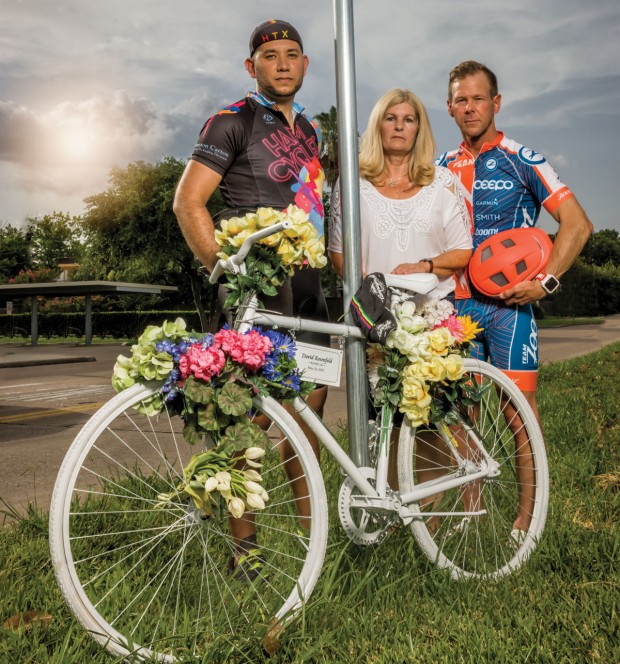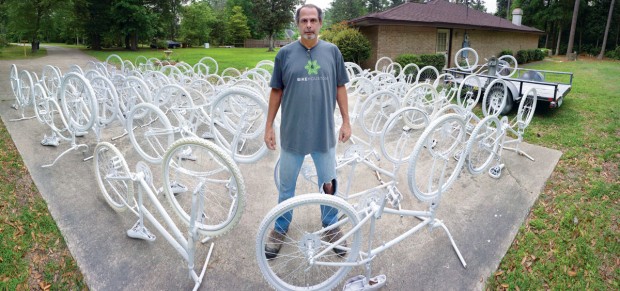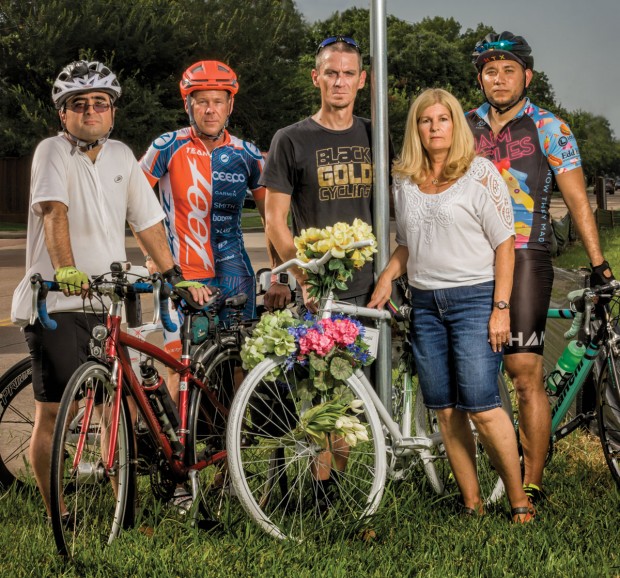Ghost Bikes
White bicycles memorialize riders


Chuy Benitez, Alexis Trevelise and Christian Wendenburg (from left) gather at the Ghost Bike honoring David Rosenfeld. (Photo: hartphoto.com)
A white bicycle affixed with a small plaque and colorful plastic flowers stands upright and still, chained to a signpost on the side of Shores Drive in Galveston.
It is a bittersweet sight for West U resident Alexis Trevelise, a painful reminder of where her husband, Jon, was riding his bicycle when a distracted driver hit him on Easter in 2014.
A year ago, Alexis would not have wished for this memorial. But these days, she sees her husband’s Ghost Bike as a place of healing, where she, family and friends can go and pay their respects to Jon.
“At first I did not want to remember the accident. I was angry, and it was hard for me,” says Alexis. “But then I talked to my sons, and I realized the Ghost Bikes are there to make people aware of how many deaths there are, and I think it is a great idea.”

Houston Ghost Bike founder Richard Tomlinson stands among Ghost Bikes he painted to memorialize cyclists who died while riding their bikes on Houston-area roads. (Photo: Chuy Benitez)
The Ghost Bike movement started in 2003 in St. Louis, Missouri. (According to the New York City Ghost Bike website, now there are more than 212 Ghost Bike groups worldwide.) Ten years after its creation, the movement made its way to Houston. Richard Tomlinson, who grew up in the Meyerland area, began Houston Ghost Bike after Chelsea Norman was struck by a car and killed while riding her bicycle home after she left work at the Whole Foods on Waugh Drive in December 2013.
“I got five or six people to join me,” said Tomlinson, who is a retired printer, “and I came up with a system that winter where I collected bikes and painted them and then I put them on a trailer and started putting them out.”
He placed the first Houston Ghost Bike in March 2014 on Old Katy Road in memory of bicyclist Cisco Rios, and as of the end of July, his group had set 62 bikes in the Greater Houston area. Volunteers collect donated bicycles, coat them with white paint and add plaques with the rider’s name and date of death.
“My objective is to get people in cars to stop hitting people on bikes,” Tomlinson says.
Steve Sims, who along with his wife, Melissa, helps run and administer Houston Ghost Bike, agrees and notes that every Ghost Bike is important. “I would like people to know that these are memorials to people and they represent children, teenagers, adults – they are anyone on a bike who is going to work or just riding around their neighborhood,” says Sims. “I do not want people to feel like they are forgotten. I’m concerned with the family and friends of victims, making them feel closure.”
The process of placing the memorial bikes is critical, says Sims, and he feels strongly about the Houston Ghost Bike mission. “One of the first bikes I put out was for a 13-year-old boy who died in 1996. His sister came to the group and asked if he could have a Ghost Bike. It was very important to her. When I showed up to set up the bike, 15 family members were there and it was very, very emotional. To see the bike made it concrete. This is what I am doing this for because people can tell their stories and know that their loved ones will be remembered, and it is a place of mourning.”
St. John’s School faculty member and competitive cyclist Chuy Benitez has been a member of Houston Ghost Bike since its start. “Suddenly the whole cycling community had a voice, and people started listening to what we had been saying for years,” Chuy says. “As an artist, I look at the Ghost Bikes as a functional installation: They are both a memorial and a warning sign. And, they are conceptual pieces that are supposed to jump out and surprise you, which is why they are all white.”

Houston Ghost Bike members John Lucci, Christian Wendenburg, Mason Courtney, Alexis Trevelise and Chuy Benitez (from left) pay tribute to David Rosenfeld at the Ghost Bike in his honor at Bissonnet and Newcastle, where he was hit by a car in May on his way to the Jon Trevelise Memorial Bike Ride. (Photo: hartphoto.com)
Houston Ghost Bike volunteers join the group via Facebook, and the numbers have mushroomed to 1,730 recently following several cycling fatalities.
“I only joined the group following the death of [Meyerland resident] David Rosenfeld. I didn’t know David, but he was a good friend of several of my friends, and it scared me to think an experienced cyclist was hit and killed in daylight on Bissonnet so close to my house,” says West U attorney Stacy Humphries. “I think the memorial bikes are like public sculpture, and they also make an excellent tribute and reminder that we all need to be more aware on the road.”
“I think it is a way to keep their spirit alive,” says Jeff Friedman, a recreational bicyclist and owner of Distinctive Life Cremations and Funerals. He didn’t know Rosenfeld but still will never forget his death. “I don’t think I will ever drive by the corner of Newcastle and Bissonnet again the same way.”
Chris Trevelise can’t drive by that corner – or any place with a Ghost Bike – without re-living the accident that claimed his father’s life. “My dad and I spent thousands of miles together on bicycles. We rode the MS 150 together eight times. We rode the Tour du Rouge from Houston to New Orleans three times. And every time now that I see a Ghost Bike it makes me sick to my stomach for that poor family. I fully support 100 percent the placing of these bikes as a memorial and as a reminder for a topic of discussion and as a call to action.”
The death of David Rosenfeld has struck a particularly difficult chord for both Alexis and Chris Trevelise. “I found out that David Rosenfeld took the time to leave his family to honor my dad [in the second annual Jon Trevelise Memorial Bike Ride], and when he got to the corner of Newcastle and Bissonnet he was hit by a car. Now he has a Ghost Bike on that corner. Now he and my dad both have Ghost Bikes. Hopefully people will pay attention.”
In Houston, the land of the car, cyclists have to be especially vigilant. “In May 2013, the City of Houston passed an ordinance that states that motor vehicles must give a 3-foot clearance when passing cyclists, and commercial vehicles are required to give a 6-foot clearance,” said Tomlinson. “If all cyclists and all motorists did their part and followed the laws that are in place, everyone on the road would be much more predictable, and there would be less chance for conflict.”
“It’s like that bumper sticker that says ‘Share the Road,’” says Larchmont resident and private investigator Christian Wendenburg, a triathlete. “I am 150 pounds, and my bike is 18 pounds, and going up against a 3,500-pound car – well that is a losing battle, unfortunately. If you see a Ghost Bike then it’s a visual reminder that hopefully makes an impact – there should be no reason why we can’t all share a little bit of the space on the road safely.”
As a longtime cyclist who commutes to work on his bike each day, Memorial-area resident John Lucci is passionate about the mission of Houston Ghost Bike. “I am hoping they will raise awareness that we are out here.”
Mason Courtney, the volunteer who made the Ghost Bike for Jon Trevelise, spent hours cleaning, prepping and painting it. Then he took the bike to the Galveston location where Jon was hit. “Jon was very respected and very well thought of, and I felt like it was a duty I had to do,” he says.
For Alexis Trevelise, it has been a painful year and a half. “I go by David Rosenfeld’s bike every day, and I put flowers there for both David and Jon now,” she says. “And so many people drive by Jon’s Ghost Bike, and they will then text me and let me know they stopped and said a prayer or put flowers on the bike, and that is really special. It shows that he is not forgotten.”
To volunteer or donate bikes, money or supplies, see the “Houston Ghost Bike” group on Facebook or go to houstonghostbike.org.
Want more buzz like this? Sign up for our Morning Buzz emails.
To leave a comment, please log in or create an account with The Buzz Magazines, Disqus, Facebook, or Twitter. Or you may post as a guest.


